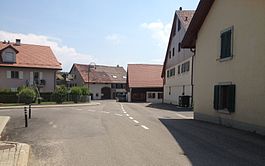Froideville, Switzerland
| Froideville | ||
|---|---|---|
 |
||
|
||
| Coordinates: 46°36′N 6°41′E / 46.600°N 6.683°ECoordinates: 46°36′N 6°41′E / 46.600°N 6.683°E | ||
| Country | Switzerland | |
| Canton | Vaud | |
| District | Gros-de-Vaud | |
| Government | ||
| • Mayor | Syndic | |
| Area | ||
| • Total | 7.08 km2 (2.73 sq mi) | |
| Elevation | 819 m (2,687 ft) | |
| Population (Dec 2016) | ||
| • Total | 2,462 | |
| • Density | 350/km2 (900/sq mi) | |
| Postal code | 1055 | |
| SFOS number | 5523 | |
| Surrounded by | Bottens, Corcelles-le-Jorat, Lausanne, Montpreveyres, Poliez-Pittet, Villars-Tiercelin | |
| Website |
www Profile (in French), SFSO statistics |
|
Froideville is a municipality in the district of Gros-de-Vaud in the canton of Vaud in Switzerland.
Froideville is first mentioned in 1284 as Frigida Villa.
Froideville has an area, as of 2009[update], of 7.08 square kilometers (2.73 sq mi). Of this area, 2.71 km2 (1.05 sq mi) or 38.3% is used for agricultural purposes, while 3.63 km2 (1.40 sq mi) or 51.3% is forested. Of the rest of the land, 0.73 km2 (0.28 sq mi) or 10.3% is settled (buildings or roads).
Of the built up area, housing and buildings made up 6.9% and transportation infrastructure made up 2.8%. Out of the forested land, all of the forested land area is covered with heavy forests. Of the agricultural land, 27.5% is used for growing crops and 10.0% is pastures.
The municipality was part of the Echallens District until it was dissolved on 31 August 2006, and Froideville became part of the new district of Gros-de-Vaud.
The municipality is located in the Jorat range.
The blazon of the municipal coat of arms is Per fess: 1. Azure a Cross Pattee Or; 2. Gules, a plough Argent.
Froideville has a population (as of December 2016[update]) of 2,462. As of 2008[update], 9.5% of the population are resident foreign nationals. Over the last 10 years (1999–2009 ) the population has changed at a rate of 16.7%. It has changed at a rate of 11.1% due to migration and at a rate of 5.7% due to births and deaths.
Most of the population (as of 2000[update]) speaks French (1,326 or 91.3%), with German being second most common (77 or 5.3%) and Italian being third (13 or 0.9%).
...
Wikipedia




